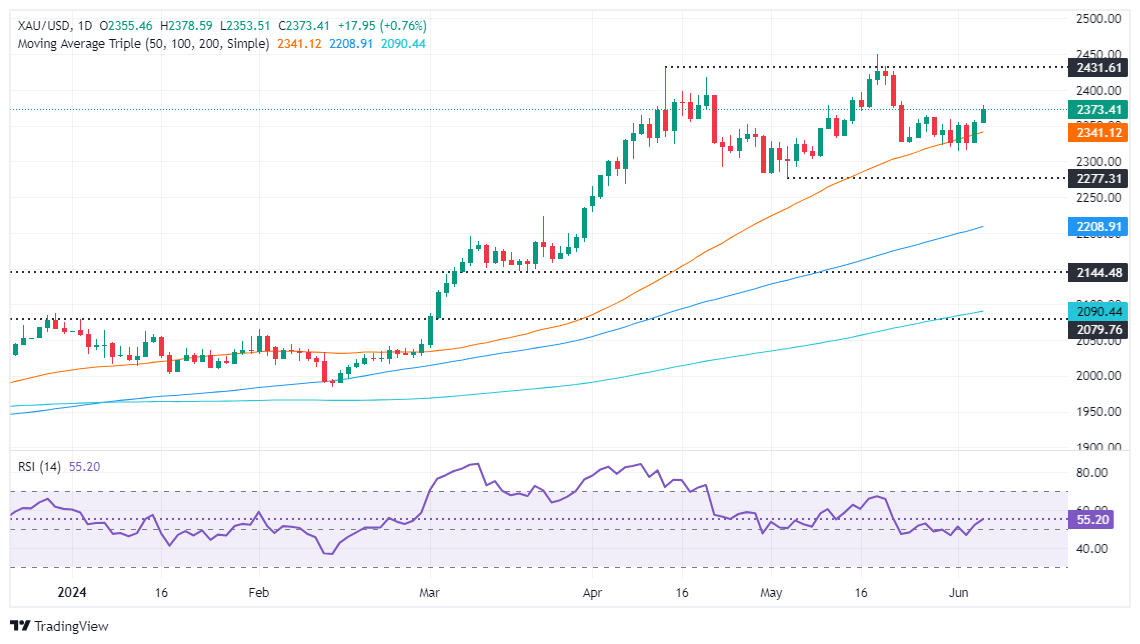Gold rose above $2,370 as traders await the important U.S. non-farm payrolls report.

- Gold prices rose 0.54% to a two-week high of $2,378.
- Higher-than-expected US jobless claims weaken the greenback and stabilize Treasury yields.
- Traders focus on upcoming non-farm payrolls. Forecasts show 185,000 new jobs will be created, with the unemployment rate at 3.9%.
Gold hit a two-week high of $2,378 on Thursday after the Bureau of Labor Statistics (BLS) released weaker-than-expected employment data that left U.S. Treasury yields little changed. XAU/USD traded at $2,369, up 0.54% after rebounding from a weekly low of $2,320.
US jobs data was one of the main drivers of the day after the BLS revealed that the number of Americans applying for unemployment benefits exceeded consensus and last week’s figures. Moreover, with the European Central Bank (ECB) deciding to cut interest rates, U.S. Treasury yields rose even before they could halt their upward trend.
The US 10-year benchmark was set to post a weekly loss, but retreated from a daily high of 4.32% to 4.285% after the ECB’s decision. Meanwhile, the U.S. dollar index, which measures the greenback’s performance against a basket of six currencies, fell 0.12% to 104.14.
Following the latest U.S. employment data, traders’ focus shifts to Friday’s May nonfarm payrolls report. Estimates show the economy is expected to add 185,000 workers, up from 175,000 in April. The unemployment rate is expected to be 3.9%, and average hourly earnings are expected to remain unchanged at 3.9%.
Daily Digest Market Drivers: Gold Prices Take Advantage of Falling U.S. Treasury Yields.
- New U.S. jobless claims rose by 229,000 for the week ending May 31, exceeding expectations of 220,000 and the previous figure of 221,000.
- ADP Employment Change shows U.S. private employment increased by 152K in May, below estimates of 175K and missing 188K in April.
- Weaker-than-expected non-farm payrolls data could increase the likelihood of a rate cut by the Federal Reserve.
- Traders are expecting a 39 basis point rate cut by the end of 2024 via December federal funds rate futures contracts, according to data from the Chicago Board of Trade (CBOT).
- According to the CME FedWatch Tool, traders currently see a 57% chance of a September rate cut.
- Last week, as the US core personal consumption expenditures price index (PCE), the Fed’s preferred inflation indicator, stabilized, expectations about the possibility of an interest rate cut increased.
Technical Analysis: Gold prices rose above $2,350.
Gold extended the rally after consolidating within the $2,320 to $2,360 area, but buyers broke the upper end of the range, opening the door for further upside. Momentum is still on the buyers side as the Relative Strength Index (RSI) remains bullish.
With further strength, the next resistance level for XAU/USD would be $2,400, followed by this year’s high at $2,450. Conversely, if the price of gold falls below $2,350, the next support level will be the 50-day simple moving average (SMA) at $2,337. The next stop is the May 8th low at $2,303, followed by the May 3rd cycle low at $2,277.

Gold FAQ
Gold has played an important role in human history, being widely used as a store of value and medium of exchange. Nowadays, in addition to being polished and used as jewelry, precious metals are widely viewed as safe assets and are considered good investments during turbulent times. Gold is also widely known as a hedge against inflation and currency depreciation because it is not dependent on a specific issuer or government.
Central banks are the largest holders of gold. With the aim of supporting their currencies during times of turmoil, central banks tend to diversify their reserves and purchase gold to improve the strength of their economy and currency. High gold reserves can be a source of confidence in a country’s solvency. Central banks added 1,136 tonnes of gold worth about $70 billion to their reserves in 2022, according to data from the World Gold Council. This is the highest annual purchase since records began. Central banks in emerging economies such as China, India and Türkiye are rapidly increasing their gold reserves.
Gold has an inverse correlation with the US dollar and US Treasury bonds, which are major reserve and safe haven assets. When the dollar falls, gold prices tend to rise, allowing investors and central banks to diversify their holdings during turbulent times. Gold also has an inverse correlation with risky assets. Rising stock markets tend to weaken gold prices, while sell-offs in risky markets tend to favor the precious metal.
Prices may fluctuate due to a variety of factors. Fears of geopolitical instability or a severe recession could cause gold prices to rise quickly due to its safe haven status. Gold, a non-yielding asset, tends to appreciate when interest rates are low, while higher money costs generally weigh on the yellow metal. Nonetheless, most of the movement will depend on how the US dollar (USD) behaves when the asset is priced in dollars (XAU/USD). A stronger dollar tends to keep gold prices in check, while a weaker dollar is likely to push gold prices higher.
Source: https://www.fxstreet.com/news/gold-price-hits-two-week-high-on-weaker-us-jobs-data-ahead-of-nfp-202406061912



